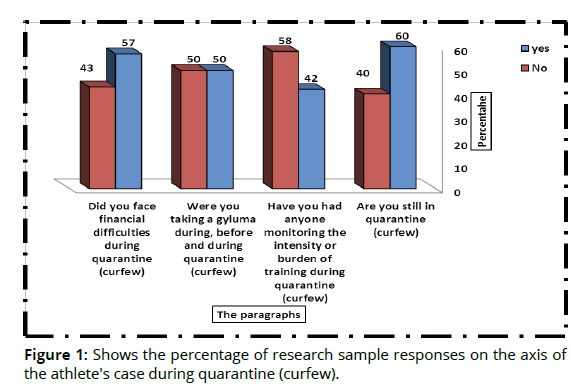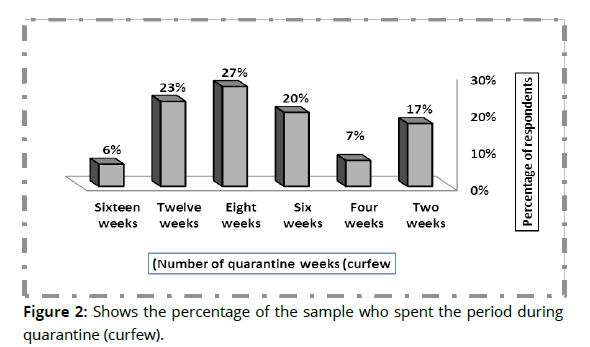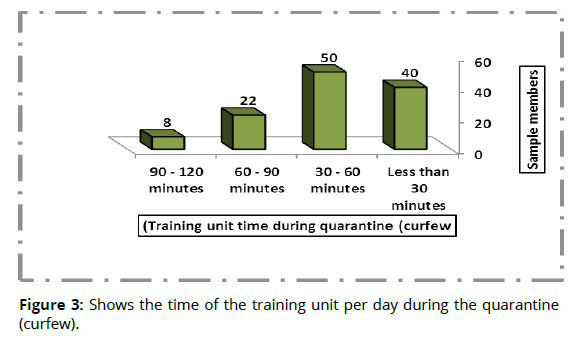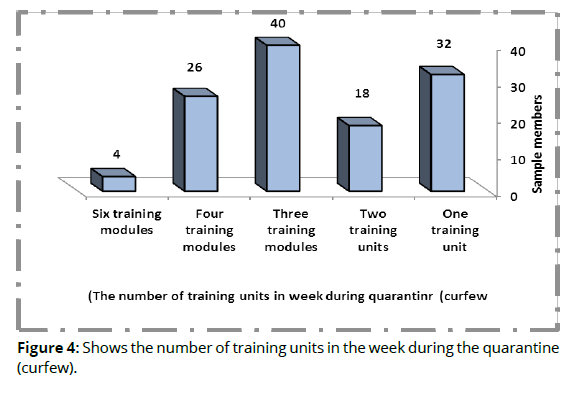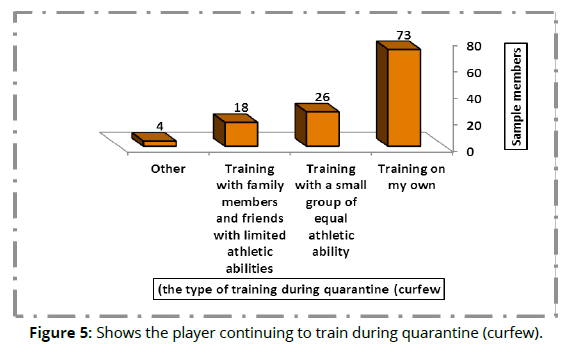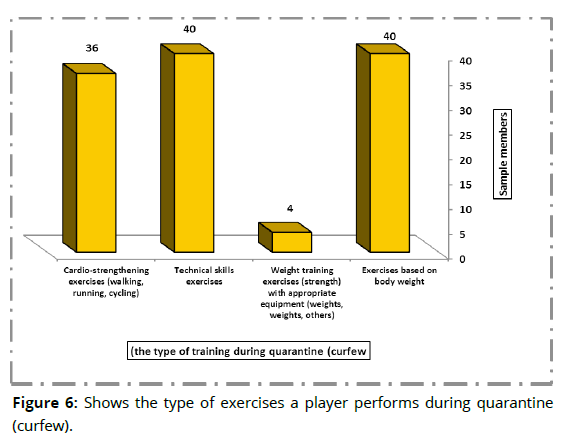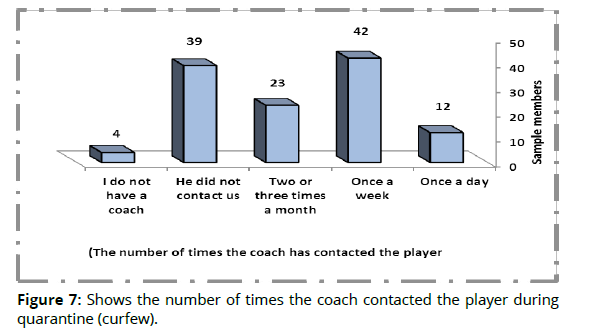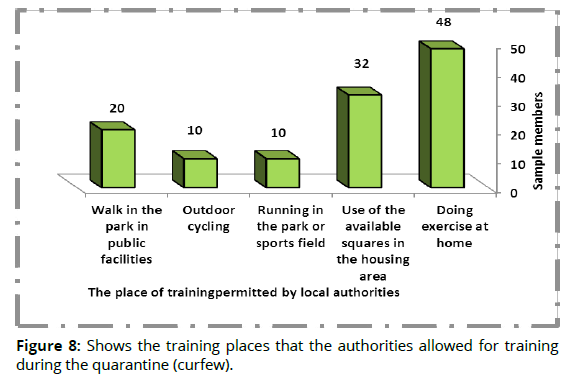Analysis of the sporting behavior of the junior Arabic fencers during the quarantine and curfew period due to the COVID-19 pandemic
Abstract
The aim of the current research is to investigate and analyzing behavior of the Arab Fencers during COVID-19 pandemic restrictions. The study has utilized a descriptive survey, that covers 120 fencers from eight Arab countries. The Arab Fencing Association was a major mediator for distributing the developed electronic questionnaire to the fencers and clubs. The statistical results obtained from the questionnaire showed that curfew periods have harmed the training conditions for the fencers and consequently on their sporting behavior. Moreover, the periodical contact between the coaches and the players has contributed significantly to maintaining athletic behavior, physical skills, psychological stability, and commitment to ethics and traditions. the study recommends that it's important to continue the current successful approach by providing encouragement and support for the fencers, to maintain their mental and physical skills. Also, special alternative training programs should be developed and prepared for the fencers to be ready for the post-pandemic. finally, it is necessary to conduct researches that tackle the negative psychological and social impacts of the COVID-19 pandemic
Keywords
Sporting behavior. Fencing. COVID-19
Introduction
The impact of the COVID-19 pandemic on human mankind was unprecedented since Spanish flu and the two world wars (Clemente-Suárez et al. 2020). No community in the globe has not been affected by all aspects of its life, including social, economic, educational, and other aspects due to the pandemic. As for sports, many international, regional and local tournaments have been canceled or postponed such as the Japan Olympics 2020. Countries have taken very strict restrictions such as vacation for schools, working from home, and quarantine for regions with high number of cases, and most importantly, lockdown to slow down the COVID 19 outbreak. The lockdown days differ by countries. Countries have set the days when the lockdown started and ended according to the COVID-19 effect on their public. Some countries have extended the lockdown by many days due to COVID-19 continues its influence intensely on the public.( Abdulkadir, 2020).
COVID-19 was described as a pandemic by the World Health Organization (WHO) (2020a). With no vaccine available and no herd immunity, most of the world governments decreed a quarantine to stop the pandemic (Clemente-Suárez et al., 2020).
To contain the spread of the virus according to the World Health Organization (WHO) and the social and economic conditions of each country, the sports decision-makers have activated several measures to protect athletes and their fans from this pandemic. The International Olympic Committee (IOC) and the International Sports Federations (IFS) called upon all athletes to self-isolate themselves, and plan for individual training away from crowds. Furthermore, it has been encouraged to use media applications such as Zoom and Teams to receive visual instructions and conduct sports group meetings.
The COVID-19 outbreak is spreading very fast every day and more than 4 million people have been actively infected by this virus so COVID-19 restrictions are applied in almost all areas of life [Worldometer, 2020]. The most basic measure to reduce the spread of coronavirus or to prevent infection is to follow hygiene rules [. Chen, al, 2020]. The most important of these is washing hands. For this reason, the spread of this virus is slower in societies that have the habit of washing hands and pay attention to the general hygiene rules [L.Y.K. Nakada, 2020]. There is a high level of participation in the "stay at home" call by official institutions. Scientists warn that the COVID-19 virus can reach any age group quickly [S. Saadat, al. 2020].
Fencing is the only combat sport that has featured at all Olympic Games since the first modern games were held in Athens in 1896. The sport has three variants, épée, foil, and sabre, each with different characteristics and rules, and accordingly, different techniques, strategies, and decision-making processes.
Apart from building on physical and coordination skills (essentially timing and sense of distance), fencing training programs need to address psychological and environmental factors, technical skills specific to the weapon (épée, foil, and saber), and preparation to help fencers analyze complex situations on their feet and take fast, accurate decisions (Aquili et al., 2013; Roi, & Bianchedi, 2008; Turner et al., 2013).
Human behavior is the outcome of experience he acquires himself or acquires from the surrounding environment. Such experience drives man to forms of behavior that could be seen or unseen. Behavior is any change in movement of level of mental, motor and emotional activity in a certain situation, which is normally a response or number of responses to certain stimuli, such as movement, speech, thinking, remembering, realization and increase or decrease in glands secretions (Hafiz, Suleiman, 2000, 19).
Sporting behaviour is the term used to reflect sportsmanship, as it pertains to ethical behaviour, fair play, and respect for the sport, the participants, and the spectators. Elite athletes have become societal role models, whether or not they wish to carry this burden. In recent years, because of increased and instantaneous media attention, the behaviour of these athletes has come under society’s microscope, off as well as on the playing field, for every aspect of their lives. As a result, elite athletes seriously influence the moral and ethical development of children and youth of many societies (Bloom, al. 2005).
Concept of Behavior means all activities conducted by person or the physical and psychological changes or actions making man adapting with surrounding and co-existing conditions in the mainstream of society to play his role. Behavior is used for indicating forms and types of human movement, such as actions, expressions and change attempts, in addition to other activities practiced by man in his daily life (Al-Lamy, 1997, 15-16).
There are some reflections appear as observable behavior. The emotions, ideas and imaginations begin internally and can not be observed, but hastily they left their effect by phenomena of reactions or motor or even physiological reflections. The athlete's behavior is embodied by a successive series of actions and reactions that appear during continuous attempts to achieve goals and fulfill the developing and changing needs (Al-Lamy, 1997, 17).
Regulation and control of athlete's behavior are by modifying, steering and improving it as desirable, and often by making friends – affecting others and controlling anger, fear and anxiety. In addition, it is controlled by forming opinions on how to regulate and steer life, such as identifying the best methods for bringing up children athletically.
The research problem is centered on responding to the following questions: Did guaranine (curfew) affect sporting behavior of Arab Fencers of 18 years and older when COVID-19 hit the world? What are the training methods employed by Arab Fencers and coaches for maintaining the physical, skill and psychological level during guaranine (curfew)? How do the Arab Fencers organize and manage the training times away from contacting other players?.
This research is significant as being the first study (to be Researchers' knowledge) that address behavioral analysis of Arab Fencers during curfew. By the results concluded by Researchers, sufficient solutions are developed for maintaining the level of athletes, contributing in continuous training to disappearance of such pandemic, and resumption of various activities, events, championships and competitions, whether international, continental or national.
Identifying the level of sporting behavior of Arab Fencers during curfew amidst COVID-19.
Methodology
This research uses a descriptive-survey, where a survey has been used as research instrument to gather data about varying subjects. This data aims to know the extent to which different conditions can be obtained among these subjects. Before distributing the questionnaire, it was presented to a group of 9 specialists in psychological tests and sports psychology to determine the validity of each section of the questionnaire and take their comments and recommendations into consideration to amend the sections. Then electronic version of the questionnaire was distributed to the study sample by publication on social media platforms (Facebook and WhatsApp) and contacting several Arab countries' coaches to be distributed to the players during the period 1-12 July 2020.
The questionnaire consists of (26) units distributed on; the athlete's condition (4) units, where the answer should be "yes or no," the management and organization of training (7) units, and the interruption in training (15) units, where the answer should be from three alternatives ( Yes, maybe, I don't know).
Besides, general information has been added to the survey, such as country name, status (amateur, semi-professional, professional), and age in years, and training age.
Data
Through close cooperation with some Arab national federations, a list of 120 registered fencers during 2019-2020, has participated in the survey by filling the electronic questionnaire. All the participants are of age 18 and above. Table 1, shows the number participants in each Arabic country. The maximum numbers are in Iraq first, and Kuwait and Egypt in second. Furthermore, the 120 participants have been classified into three groups according to maturity and professionalism in fencing as shown in (Table 2). The amateur fencers represent the highest percentage with 45%, where semi-professional fencers come second with 40%. A minimal number of professionals participated in this survey, representing only 15%. All the participants in the survey have been involved in different levels of championships before the pandemic. The number of involvement and its percentage is demonstrated in Table 3. Since most participants are from amateur and semi-professionals, the highest rate of involvement is in national championships (Tables 1-4).
| Country | Number | Country | Number |
|---|---|---|---|
| Iraq | 35 | Egypt | 26 |
| Kuwait | 26 | KSA | 12 |
| Jordan | 9 | UAE | 5 |
| Bahrain | 4 | Morocco | 3 |
| Category | Number | Percentage |
|---|---|---|
| Amateur (unremunerated for practicing the sport) | 54 | 45% |
| Semi-professional (remunerated for practicing the sport and other activity) |
48 | 40% |
| Professional (remunerated only for practicing the sport) |
18 | 15% |
| Total | 120 | 100% |
| Championship | Number | Percentage |
|---|---|---|
| National | 60 | 50% |
| Olympics and World Championships | 22 | 18.33% |
| Continental | 26 | 21.67% |
| Arab | 12 | 10% |
| Total | 120 | 100% |
| Variables | Mean | Standard Deviation (SD) | Average | Coefficient of Skewness (Sc) |
Standard Error (SE) |
|---|---|---|---|---|---|
| Age by years | 25.3167 | 5.42169 | 25.000 | 0.318 | 0.49493 |
| Training age by years | 9.1833 | 5.49558 | 8.500 | 0.884 | 0.50168 |
All the data analysis conducted in this study was done by using the SPSS statistical software.
Presentation and Interpretation of Results
Presentation of response results of study sample to items of athlete's state during curfew (Figure 1).
Presentation of results of training organization and management during quarantine (curfew) for Fencers (Figures 2-8).
Presentation of results of weighted average and relative weight for cessation of training during curfew (Table 5).
| S. | Item | Weighted Average | Relative Weight |
|---|---|---|---|
| 1. | Quarantine (curfew) resulting in less training could lead to or capable of decreasing the level of fitness | 2.58 | 86% |
| 2. | To maintain my fitness, I should keep intensity of training high. | 2.66 | 88.67% |
| 3. | In case I decreased the ratio of training (number of training unit per week) of 30% or more, my fitness will decline in few weeks. |
2.44 | 81.33% |
| 4. | Quarantine (curfew) could decrease or decreased my technical skills. | 2.44 | 81.33% |
| 5. | Quarantine (curfew) is a challenge for my mental health. | 2.23 | 74.44% |
| 6. | During the period of Quarantine (curfew), I can maintain my physical fitness (endurability and muscular power) by high-tense intermittent training based on body weight. |
2.43 | 81% |
| 7. | During Quarantine (curfew), I can perform normal training regularly. | 1.96 | 65.28% |
| 8. | Less than 4 weeks of quarantine (curfew) shall have a minimum or no effect on level of fitness. | 2.23 | 74.44% |
| 9. | My coach wants me to keep my fitness during quarantine (curfew). | 2.42 | 80.6% |
| 10. | During the period of quarantine (curfew), I think interaction with my coach by communication (such as videoconferencing, messages, phone calls, etc.) is enough and effective. |
2.38 | 79.44% |
| 11. | I wanted training during the period of quarantine (curfew) but I did not know how. | 2.37 | 79% |
| 12. | Videoconferencing / online sessions / TV shows could help train using a limited number of equipment necessary for athletes for keeping their fitness. |
2.22 | 74% |
| 13. | Training during quarantine (curfew) is often boring and less attractive. | 2.68 | 89.33% |
| 14. | During quarantine (curfew), I continuously felt afraid of catching COVID-19. | 2.25 | 75% |
| 15. | Lack of competition and championships affected by drive and appetite for training. | 2.65 | 88.33% |
Results and Discussions
Figure 1 shows the athlete's state during quarantine (curfew), as the percentage of (Yes) responses to the question (Are you still in quarantine (curfew)?) was 60%, while percentage of (No) responses was 40%.
The percentage of (Yes) responses to the question (Did or do you have any person watching the intensity or burden of training during quarantine (curfew)?) was 42%, while percentage of (No) responses was 58%.
The percentage of (Yes) responses to the question (Usually I had a nap during the day before and during quarantine (curfew)?) was 50%, while percentage of (No) responses was 50%.
The percentage of (Yes) responses to the question (During quarantine (curfew) I face (or faced) financial problems?) was 57%, while percentage of (No) responses was 43%.
According to the responses of such topic, the state of Arab Fencers was variedly affected, which was reflected on their sporting behavior, as their fellow-citizens were affected by quarantine (curfew), as they are a part of society where they live. Therefore, the behavior is the sole source observable in person. We can not infer the mental activities, emotions and ideas unless by behavior, as being the objective description of person's actions, whether a motor action or intellectual activity. The person moves, such as walking and moving his arms, legs or head, only when concentration is internal (Yasin and Mahmoud, 1990, p. 42).
Sports widely exist in people’s daily life, most people are very fond of watching sports events, and sports exercise is a good way to relax and entertain. However, when carrying out sports activities, whether it is spectators or athletes, sometimes, due to the change of the psychological and emotional state, various sports attacks that are difficult to estimate and predict occur, and these unexpected events can easily evolve into violent conflicts, resulting in the bad influence of public order-disorder, which not only affects the normal conduct of the competition but also brings negative sports impression to the audience, especially teenagers. Based on the above background analysis [Y. Chantal, al. 2005].
As for Figures (2-8), embodying the topic of training organization and management during quarantine (curfew) for Arab Fencers, we can observe variation between number of weeks spent in quarantine (curfew) and number of training units practiced during the week, in addition to the time and sort of trainings performed by them and the number of coach follow-ups and places where they were training. Such variation affected in a way or another their sporting behavior, as the sporting behavior is the outcome of experience acquired by themselves or acquired for the surrounding environment (team, playground, fans, society). Such experience drives and encourages them to the sorts of behavior, which could be seen or unseen, in addition to the physical and mental changes and actions making the athlete adapting to the occurring and coexisting circumstances in the society to play his role therein. (Al-Lamy, 1995, 15-16).
This complies with a study (Peijie Chen, et al, 2020) titled "Coronavirus Disease (COVID-19): The Need to Maintain Regular Physical Activity while Taking Precautions", which results confirmed that physical activity for various age group has significant importance for supporting the psychological and health condition and optimizing the body's instinctive immunity. Clearly behavioral analysis is much more than simply measuring overt dependent variables such as sport performance or physical activity since this eschews philosophical questions of causality and agentic behavior. However, the focus on overt behavior shared by both behavior analysts and traditional sport and exercise psychologists and their shared recognition of the importance of conducting ecologically valid research constitutes major points of agreement upon which collaborative relationships could be built. Moreover (Martin and Thompson , 2011).
For Table (5) showing the results of weighted average and relative weight for items of cessation of training during quarantine, ranging from 89.33% to 74%. They are high percentages indicating the impact of cessation of training with peers and co-players, whether at the sports club or team, under direct supervision of the coach, on the athletes' training behavior. Whether the sports traditions, customs and ethics, as being behaviors that are formed across the sports history and accumulatively, until they are deemed amongst the customs and traditions adopted in the mainstream of sports competition, which are adopted by some sports and are included in game rules and competition laws, such as greeting the competitors, referees, fans and public at the beginning of matches (Al-Kholy, Anan, 1999, 128).
This reflects a behavioral-analysis approach, that is, a focus on the environment as a primary factor in controlling behavior, although often this research is embedded within a social-cognitive ecological perspective. (Martin & Thompson ، 2011).
Conclusions
Through results, the Researchers concluded the following significant conclusions:
1. Quarantine (Curfew) adversely affected the training state of Arab Fencers and, consequently, their sporting behavior.
2. Arab Fencers exerted efforts for maintaining their health and physical fitness in particular, by doing regular exercises in different weekly training units and times during quarantine (curfew).
3. Daily or weekly contact of coaches with players contributed in maintaining their sporting behavior and observance of traditions and social ethics to removal of health precautions on disappearance of pandemic.
Recommendations
The Researchers recommended the following:
1. Necessary encouragement and support for Arab Fencers by their coaches and Arab Fencing Federations for continuous training to maintain their physical, skill and psychological potentials as far as possible.
2. Necessary organization of virtual championships among Arab Fencers online and for various categories.
3. Necessary approval of alternative training programs for Fencers and qualifying to post-pandemic stage.
4. Conducting studies and researches that reinforce psychological and social aspects for facing the passive impact of Coronavirus (COVID-19).
References
Tobías, C. Carnerero, C. Reche, J. Massagué, M. Via, M.C. Minguillón, A. Alastuey, X. Querol, Changes in air quality during the lockdown in Barcelona (Spain) one month into the SARS-CoV-2 epidemic, Sci. Total Environ. 726 (2020), https://doi.org/10.1016/J.SCITOTENV.2020.138540 138540
Abdulkadir Atalan; Is the lockdown important to prevent the COVID-19 pandemic? Effects on psychology, environment and economy-perspective, Annals of Medicine and Surgery, 56 (2020), 38-42.
Al-Kholy, Amin Anwar, Anan, Mahmoud (1999); Sports Cognition, Dar Elfikr Elaraby, Cairo.
Al-Lamy, Abdullah Hussein (1997); Evaluation of Training Behavior of Coaches of Premier and First-Class Football Tournament Clubs in Iraq for 1995-1996, Unpublished PhD Theses, Faculty of Physical Education, Baghdad University.
Al-Lamy, Zakiyah Hameed (1995); Preferential Behavior of Baghdad University Students: Construction and Application, Unpublished MA Thesis, Faculty of Physical Education, Baghdad University.
Aquili, A., Tancredi, V., Triossi, T., Sanctis, D., Padua, E., D'Arcangelo, G., & Melchiorri, G. (2013). Performance Analysis in Saber. The Journal of Strength y Conditioning Research, 27(3).
B. Chen, H. Liang, X. Yuan, Y. Hu, M. Xu, Y. Zhao, B. Zhang, F. Tian, X. Zhu, Roles of meteorological conditions in COVID-19 transmission on a worldwide scale, MedRxiv (2020), https://doi.org/10.1101/2020.03.16.20037168.
Bloom, Michael, Michael Grant, and Douglas Watt. “Chapter 6: Skills Impacts.” Strengthening Canada: The Socio-economic Benefits of Sport Participation in Canada—Report August 2005. Ottawa, ON: The Conference Board of Canada, 2005.
Hafiz, Nabil Abdulfattah, and Suleiman, Abdulrahman Sayed (2000); Sociopsychology, Ed. 1, Cairo, Zahran Al-Sharq Library.
L.Y.K. Nakada, R.C. Urban, COVID-19 pandemic: impacts on the air quality during the partial lockdown in São Paulo state, Brazil, Sci. Total Environ. 730 (2020), https://doi.org/10.1016/j.scitotenv.2020.139087.
Martin, G. L., & Thompson, K. (2011). Overview of behavioral sport psychology. In J. K. Luiselli & D. D. Reed (Eds.), Behavioral sport psychology: Evidence based approaches to performance enhancement (pp. 3–21). New York, NY: Springer. http://dx.doi.org/10.1007/978-1-4614-0070-7_1.
Peijie Chen, et al, (2020), Coronavirus disease (COVID-19): The need to maintain regular physical activity while taking precautions, Shanghai University of Sport, Shanghai 200438, China.
Roi, G.S., & Bianchedi, D. (2008). The science of fencing: implications for performance and injury prevention. Sports Medicine, 38(6), 465-481.
S. Saadat, D. Rawtani, C.M. Hussain, Environmental perspective of COVID-19, Sci. Total Environ. 728 (2020). https://doi.org/10.1016/j.scitotenv.2020.138870.138870.
Turner, A., Miller, S., Stewart, P., Cree, J., Ingram, R., Dimitriou, L., Moody, J., & Kilduff, L. (2013). Strength and Conditioning for Fencing. Strength & Conditioning Journal, 35(1), 1-9.
Wang C, Cheng Z, Yue X McAleer M (2020) Risk Management of COVID-19 by Universities in China. Multidisciplinary Digital Publishing Institute 13. Link: https://bit.ly/3cXFpt6.
World Health Organization. (2018) :PA for health. More active people for a healthier world: draft global action plan on PA.
www.edu.gov.mb.ca/k12/cur/physhlth/
www.pch.gc.ca/progs/sc/pubs/socio-eco/6_e.cfm
Y. Chantal, P. Robin, J.-P. Vernat, and I. Bernache-Assollant, “Motivation, sportspersonship, and athletic aggression: a mediational analysis,” Psychology of Sport and Exercise, vol. 6 no. 2, pp. 233–249, 2005.
Yasin, Wadea, and Al-Obaidi, Hassan Mohammed (1990); Statistical Applications and Employment of Computer in Physical Education Researches, Dar Al-Kotob Printing and Publishing, Mosul University.
World Health Organization (WHO) (2020c). WHO Director-General’s opening remarks at the media briefing on COVID-19 - March 11 2020. Available online at: https://www.who.int/dg/speeches/detail/who-director-general-s-openingremarks-at-the-media-briefing-on-covid-19---11-march-2020.
Clemente-Suárez, V. J., Hormeño-Holgado, A., Jiménez, M., Benitez- gudelo, J. C., Navarro-Jiménez, E., Perez-Palencia, N., et al. (2020). Dynamics of population immunity due to the herd Effect in the COVID-19 pandemic. Vaccines 8:236. doi: 10.3390/vaccines8020236.
Author Info
1General Directorate of Education, Diyala, Iraq2College of Physical Education and Sport Sciences for Women, University of Baghdad, Iraq
3Kuwait Sports Club, Kuwait
Received: 15-Jan-2023 Accepted: 20-Feb-2023 Published: 27-Feb-2023
